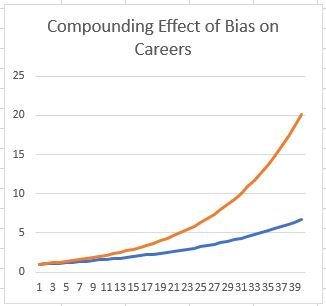
Most of us believe in meritocracy. We believe that hard work pays off and people generally get what they deserve based on their skills and efforts.
If our industry was a meritocracy, why do so few women and people of color make it to senior positions?
Are they less talented?
Study after study illustrate commonplace bias that indicate our organizations are likely less meritocratic than we would like to believe.
In fact, studies show that organizations that consider themselves the most meritocratic are actually often the least meritocratic.
Consider the Compounding Effect of Small Bias Events
Imagine two careers:
1: The person has performance rounded up, slightly faster promotions and raises.
2: The other person has performance slightly rounded down and a bit longer for each promotion and raise.
Just like the impact of compounding interest on investment returns over time, the compounded impact of small bias acts can have profound impacts on careers.
Bias is more likely to occur to people from underrepresented groups. About 70% of college grads are people of color and/or women. How much of the talent pool you are missing?

We all fall into unconscious bias traps. We need to look for it and take steps to counteract it.
Learn About Some Common Types of Bias…
Tightrope Bias
Some groups need to walk the line between conflicting expectations of workplace competence and societal expectations.
Societal expectations for workplace competence and leadership may contradict societal expectations for women and other underrepresented groups.
Stat: Success and likeability are positively correlated for men and negatively correlated for women.
A man can be assertive, competitive and ambitions and be perceived as both competent and likeable.
A woman is expected to be nice, helpful, and modest.
Can lead to conflicting perceptions and feedback. They are either competent leader but not likeable (too pushy, arrogant) or likeable but not a leader (lacks executive presence, not strong enough). Women often receive negative feedback on both competency and likeability.
The tightrope experience also applies to other underrepresented groups due to other cultural stereotypes.
Impact to People in Tightrope Groups
Tightrope groups are penalized for having to be two things at once that majority men don’t experience.
Tightrope groups often carry additional mental load and work to accommodate conflicting expectations.
Can impact perceived and real fairness in the workplace
Can decrease morale and enjoyment at work.
Prove It Again Bias
Some groups have to prove themselves more than others.
Employees from underrepresented groups tend to have to prove themselves more than others to achieve the same career outcome.
Some groups are judged on past performance, while others on potential.
Example: “He’ll crush it.” versus “She’s not ready.”
Some groups’ successes are attributed to luck, while others are attributed to skill.
Example: “He’s skilled” versus “They got lucky”
Some groups’ mistakes tend to be noticed more and remembered longer, while others’ mistakes tend to be written off.
Example: “It could happen to anyone” versus “They blew it.”
Can be more heightened if someone is the “only one.”
Job criteria more likely waived for some people than others
Can lead to under-leveling: placing someone at a lower level than their skills would justify
Affinity Bias
There is an impact of gravitating toward people like ourselves.
We gravitate towards people like ourselves. And may avoid or even dislike people who are different from us.
More likely to mentor and advocate for people like us.
May have more informal work interactions with direct reports and colleagues who are more like us and give less access to those more different.
In performance assessments, we may confuse “liking someone” (often for similarities) with “good performance and potential.”
Companies may seek “culture fit” and miss “adding to the culture” when hiring candidates
Maternal Wall Bias
Motherhood triggers false assumptions that women are less committed to their careers- and even less competent.
Bias against mothers is a strong form of gender bias.
When women have children, there is often the assumption that their ability to commit to the job decreased.
When men have children, there is often a positive bias that their bread winning needs increase. “He has a family to support.”
Mothers are often assumed to have lower career ambitions. Plum assignments or promotions may be withheld on the assumption the women will not - or should not want them.


